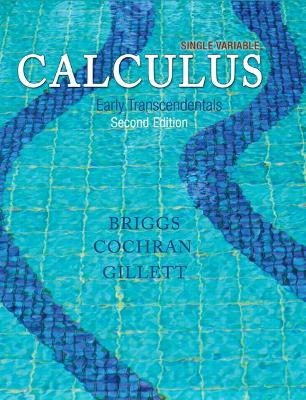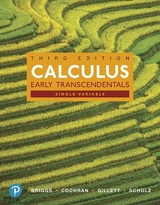
Single Variable Calculus
Pearson (Verlag)
978-0-321-95423-7 (ISBN)
- Titel erscheint in neuer Auflage
- Artikel merken
KEY TOPICS: Functions; Limits; Derivatives; Applications of the Derivative; Integration; Applications of Integration; Integration Techniques; Sequences and Infinite Series; Power Series; Parametric and Polar Curves
MARKET: For all readers interested in calculus.
William Briggs has been on the mathematics faculty at the University of Colorado at Denver for twenty-three years. He received his BA in mathematics from the University of Colorado and his MS and PhD in applied mathematics from Harvard University. He teaches undergraduate and graduate courses throughout the mathematics curriculum with a special interest in mathematical modeling and differential equations as it applies to problems in the biosciences. He has written a quantitative reasoning textbook, Using and Understanding Mathematics; an undergraduate problem solving book, Ants, Bikes, and Clocks; and two tutorial monographs, The Multigrid Tutorial and The DFT: An Owner’s Manual for the Discrete Fourier Transform. He is the Society for Industrial and Applied Mathematics (SIAM) Vice President for Education, a University of Colorado President’s Teaching Scholar, a recipient of the Outstanding Teacher Award of the Rocky Mountain Section of the Mathematical Association of America (MAA), and the recipient of a Fulbright Fellowship to Ireland. Lyle Cochran is a professor of mathematics at Whitworth University in Spokane, Washington. He holds BS degrees in mathematics and mathematics education from Oregon State University and a MS and PhD in mathematics from Washington State University. He has taught a wide variety of undergraduate mathematics courses at Washington State University, Fresno Pacific University, and, since 1995, at Whitworth University. His expertise is in mathematical analysis, and he has a special interest in the integration of technology and mathematics education. He has written technology materials for leading calculus and linear algebra textbooks including the Instructor’s Mathematica Manual for Linear Algebra and Its Applications by David C. Lay and the Mathematica Technology Resource Manual for Thomas’ Calculus. He is a member of the MAA and a former chair of the Department of Mathematics and Computer Science at Whitworth University. Bernard Gillett is a Senior Instructor at the University of Colorado at Boulder; his primary focus is undergraduate education. He has taught a wide variety of mathematics courses over a twenty-year career, receiving five teaching awards in that time. Bernard authored a software package for algebra, trigonometry, and precalculus; the Student’s Guide and Solutions Manual and the Instructor’s Guide and Solutions Manual for Using and Understanding Mathematics by Briggs and Bennett; and the Instructor’s Resource Guide and Test Bank for Calculus and Calculus: Early Transcendentals by Briggs, Cochran, and Gillett. Bernard is also an avid rock climber and has published four climbing guides for the mountains in and surrounding Rocky Mountain National Park.
1. Functions
1.1 Review of functions
1.2 Representing functions
1.3 Inverse, exponential, and logarithmic functions
1.4 Trigonometric functions and their inverses
2. Limits
2.1 The idea of limits
2.2 Definitions of limits
2.3 Techniques for computing limits
2.4 Infinite limits
2.5 Limits at infinity
2.6 Continuity
2.7 Precise definitions of limits
3. Derivatives
3.1 Introducing the derivative
3.2 Working with derivatives
3.3 Rules of differentiation
3.4 The product and quotient rules
3.5 Derivatives of trigonometric functions
3.6 Derivatives as rates of change
3.7 The Chain Rule
3.8 Implicit differentiation
3.9 Derivatives of logarithmic and exponential functions
3.10 Derivatives of inverse trigonometric functions
3.11 Related rates
4. Applications of the Derivative
4.1 Maxima and minima
4.2 What derivatives tell us
4.3 Graphing functions
4.4 Optimization problems
4.5 Linear approximation and differentials
4.6 Mean Value Theorem
4.7 L’Hôpital’s Rule
4.8 Newton’s Method
4.9 Antiderivatives
5. Integration
5.1 Approximating areas under curves
5.2 Definite integrals
5.3 Fundamental Theorem of Calculus
5.4 Working with integrals
5.5 Substitution rule
6. Applications of Integration
6.1 Velocity and net change
6.2 Regions between curves
6.3 Volume by slicing
6.4 Volume by shells
6.5 Length of curves
6.6 Surface area
6.7 Physical applications
6.8 Logarithmic and exponential functions revisited
6.9 Exponential models
6.10 Hyperbolic functions
7. Integration Techniques
7.1 Basic approaches
7.2 Integration by parts
7.3 Trigonometric integrals
7.4 Trigonometric substitutions
7.5 Partial fractions
7.6 Other integration strategies
7.7 Numerical integration
7.8 Improper integrals
7.9 Introduction to differential equations
8. Sequences and Infinite Series
8.1 An overview
8.2 Sequences
8.3 Infinite series
8.4 The Divergence and Integral Tests
8.5 The Ratio, Root, and Comparison Tests
8.6 Alternating series
9. Power Series
9.1 Approximating functions with polynomials
9.2 Properties of Power series
9.3 Taylor series
9.4 Working with Taylor series
10. Parametric and Polar Curves
10.1 Parametric equations
10.2 Polar coordinates
10.3 Calculus in polar coordinates
10.4 Conic sections
| Erscheint lt. Verlag | 12.2.2014 |
|---|---|
| Sprache | englisch |
| Maße | 100 x 100 mm |
| Gewicht | 100 g |
| Themenwelt | Mathematik / Informatik ► Mathematik ► Analysis |
| ISBN-10 | 0-321-95423-8 / 0321954238 |
| ISBN-13 | 978-0-321-95423-7 / 9780321954237 |
| Zustand | Neuware |
| Haben Sie eine Frage zum Produkt? |
aus dem Bereich



